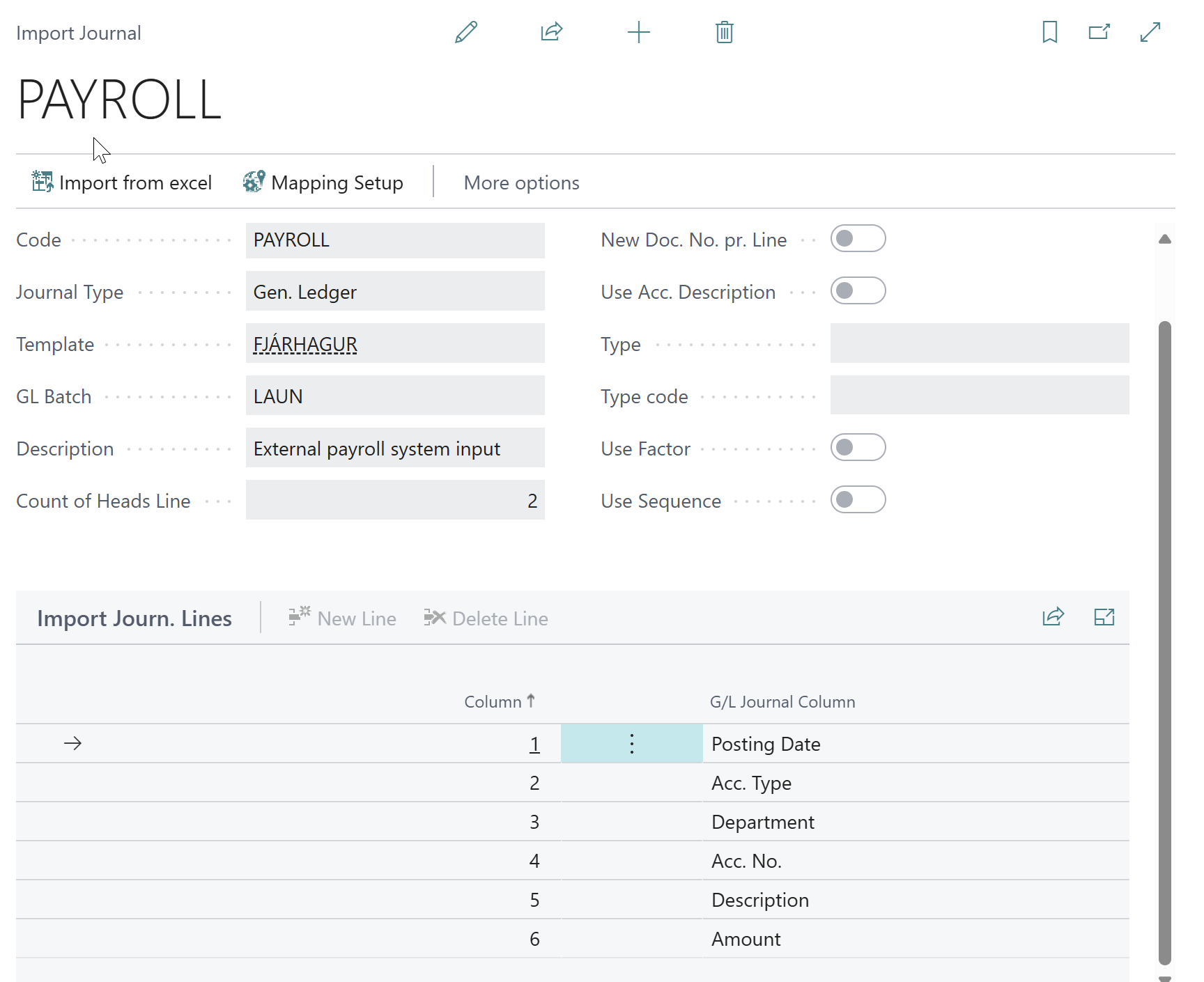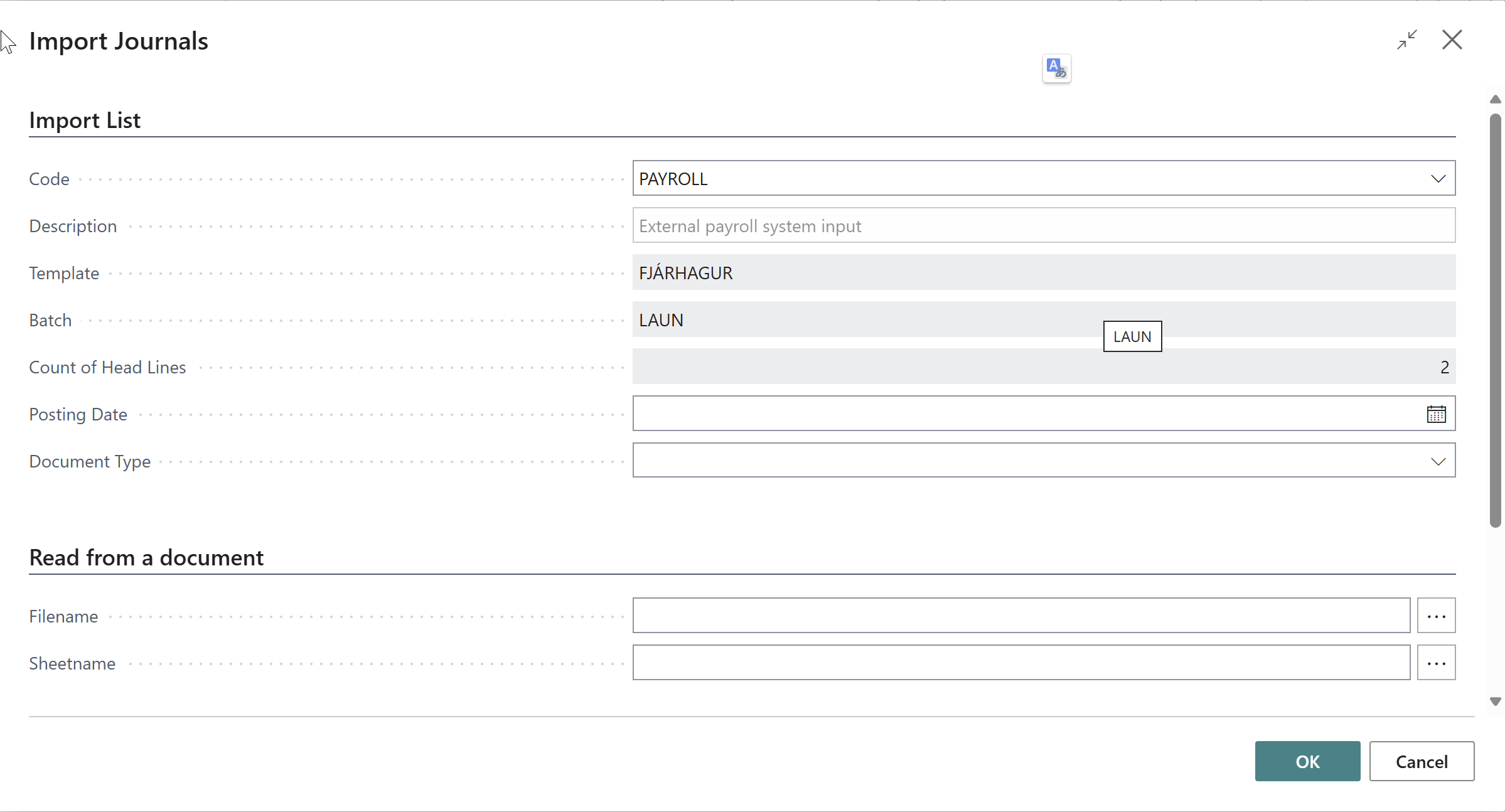Import Journals
The Import Journals module in Wise Municipal Manager provides powerful tools for importing financial data from Excel files into various journal types. This functionality streamlines data entry processes and ensures accurate transfer of external financial information into Business Central.

Import Journal list
Key Features
Multi-Journal Support
General Ledger Journals: Import standard general ledger transactions
Fixed Asset Journals: Import fixed asset acquisitions and depreciation
Payment Journals: Import vendor payments with automatic vendor creation
Invoice Batch Lines: Import customer invoicing data with line-level detail
Liquid Asset Management: Import movable asset registrations
Advanced Excel Integration
Flexible Column Mapping: Map Excel columns to Business Central fields
Sheet Selection: Choose specific worksheets from Excel workbooks
Header Line Handling: Skip header rows automatically
Multi-dimensional Data: Support for departments, projects, and business accounts
Data Validation: Built-in validation and error checking
Automated Processing
Document Number Generation: Automatic document numbering
Customer/Vendor Creation: Auto-create missing customers and vendors
Business Account Mapping: Complex mapping based on account, dimension, and business account combinations
Dimension Management: Automatic dimension code validation and assignment
Journal Types and Applications
1. General Ledger Journals

Setup Import journal
Purpose
Import standard accounting transactions from external systems or spreadsheets into Business Central general journals.
Supported Fields
Account Information: Account type, account number, description
Transaction Details: Posting date, document type, document number, amount
Dimensions: Department (Global Dimension 1), Project (Global Dimension 2)
Business Classification: Business account codes for municipal categorization
Additional Fields: Source code, job number, external document number
Fixed Asset Fields: FA posting type, depreciation book code
Balance Account: Balancing account type and number with dimensions
Column Mapping Options
Account Type: G/L Account, Customer, Vendor, Bank Account, Fixed Asset
Account Number: With automatic formatting and validation
Posting Date: Date validation and format conversion
Document Type: Payment, Invoice, Credit Memo, Finance Charge Memo, Reminder, Refund
Description: Text concatenation from multiple columns
Amount: Numeric validation with decimal handling
Dimensions: Department and project code validation
Business Account: Municipal business account classification

Excel import journal
Import Process
Setup: Define import template with column mappings
File Upload: Select Excel file and worksheet
Preview: Review data mapping and validation results
Import: Process data into selected general journal batch
Review: Verify imported transactions in General Journal
2. Fixed Asset Journals
Purpose
Import fixed asset transactions including acquisitions, depreciation, and disposals.
Supported Fields
Asset Information: Fixed asset number, posting group
Transaction Types: Initial cost, depreciation, write-down, appreciation, disposal
Financial Details: Amount, salvage value, depreciation book
Documentation: Document number, external document number, description
Date Management: Posting date, document date, FA posting date
FA Posting Types
Initial Cost (Stofnkostnaður): Asset acquisition costs
Depreciation (Afskriftir): Periodic depreciation entries
Write-Down (Niðurfærsla): Asset impairment adjustments
Appreciation (Uppfærsla): Asset revaluation increases
Maintenance (Viðhald): Maintenance and repair costs
Screenshot Placeholder: Fixed Asset import showing posting type selection and asset mapping
3. Payment Journals
Purpose
Import vendor payment information with automatic vendor creation and bank account setup.
Supported Fields
Payment Details: Amount, posting date, document number
Vendor Information: Vendor number, name, social security number
Banking Details: Bank number, bank account, account owner
Dimensions: Department, project, business account classification
References: External document number, description
Automatic Vendor Creation
When importing payments for non-existing vendors, the system automatically:
Validates Icelandic social security numbers (kennitala)
Creates vendor records with basic information
Sets up vendor bank accounts with proper formatting
Formats bank account numbers to Icelandic standards (XXXX-XX-XXXXXX)
Assigns default payment terms and posting groups
Screenshot Placeholder: Payment import showing automatic vendor creation dialog
Bank Account Processing
Bank Number: Validates and formats to 4-digit standard
Account Head Number: Formats to 2-digit standard
Account Number: Formats to 6-digit standard with proper hyphenation
Account Owner: Links to vendor social security number
4. Invoice Batch Lines
Purpose
Import detailed customer invoicing data for batch invoice processing.
Supported Fields
Customer Information: Customer number with automatic kennitala validation
Line Details: Description, quantity, unit price, discount percentage
Item/Service: Type (Item, G/L Account, Resource), number, business account
Dimensions: Department, project codes
Additional Text: Before/after line text insertion options
Advanced Features
Customer Auto-Creation: Creates customers from social security numbers
Text Line Management: Insert promotional or informational text
Business Account Integration: Links to municipal service categories
Multi-line Processing: Handles complex invoice structures
Description Concatenation: Builds descriptions from multiple Excel columns
Text Line Options
Before Every Line: Insert text before each invoice line
Top of Invoice: Insert text at invoice header
Before/After: Add text before or after specific line descriptions
5. Liquid Asset Management
Purpose
Import movable asset registrations for municipal asset tracking.
Supported Fields
Asset Identification: Asset number, description, serial number
Classification: FA class, subclass, location, sublocation
Physical Details: Units, acquisition year, acquisition cost
Management: Vendor information, maintenance vendor, global dimensions
Asset Categories
Infrastructure: Vehicles, machinery, equipment
Office Equipment: Computers, furniture, technology
Tools and Equipment: Specialized municipal tools
Facilities: Movable facility assets
Import Configuration and Setup
Import Journal Header Setup
Basic Configuration
Code: Unique identifier for the import template
Journal Type: Determines import behavior and target journal
Template/Batch: Target journal template and batch
Description: User-friendly template description
Advanced Options
Count Heads Line: Number of header rows to skip in Excel
New Doc. No. per Line: Generate unique document numbers per line
Use Account Description: Use account name as transaction description
Business Account: Default business account for all imported lines
Type/Type Code: Default account type and number for lines without account specification
Processing Options
Use Factor: Apply multiplication factors during import
Use Sequence: Process columns in specific sequence order
Column Mapping Setup
Mapping Configuration
Access through Import Journals → Mapping Setup
General Ledger Column Mappings
Account Type: Maps to G/L Journal Account Type enum
Account No.: Maps to Account No. with formatting rules
Posting Date: Maps to Posting Date with date validation
Document Type: Maps to Document Type enum
Document No.: Maps to Document No. field
Description: Maps to Description with concatenation options
Department: Maps to Shortcut Dimension 1 Code
Project: Maps to Shortcut Dimension 2 Code with validation
Amount: Maps to Amount with numeric validation
Business Account: Maps to Sve Business Account with validation
Advanced Mapping Options
Fixed Type/No.: Override account type and number for specific columns
Description Line: Use fixed description instead of Excel content
New Line: Create new journal line for this column
Import Sequence: Control processing order of columns
Factor: Apply multiplication factor to numeric values
Complex Account Mapping
The system supports sophisticated account mapping based on multiple criteria:
Mapping Hierarchy (Priority Order)
Exact Match: Account + Dimension + Business Account
Account + Dimension: Without business account specification
Account + Business Account: Without dimension specification
Account Only: Basic account-level mapping
Dimension + Business Account: Without specific account
Dimension Only: Department-based mapping
Business Account Only: Service-type based mapping
Use Cases
Department-Specific Accounts: Map expenses to different accounts by department
Service-Type Routing: Route revenues to accounts based on business account type
Project Accounting: Direct project costs to specific account structures
Default Handling: Provide fallback mappings for unmapped combinations
Import Process Workflow
Step 1: Template Setup
Navigate to Import Journals → Setup
Create new import journal header
Configure journal type and target batch
Set processing options and defaults
Step 2: Column Mapping
Open Mapping Setup from import journal
Define Excel column to BC field mappings
Set up complex mapping rules if needed
Configure text line insertions for invoice batches
Step 3: File Upload and Import
Open import journal template
Use Import from Excel action
Select Excel file and worksheet
Review import parameters
Execute import process
Step 4: Validation and Review
System validates imported data
Creates missing customers/vendors if configured
Applies complex mapping rules
Generates journal lines in target batch
Opens target journal for review
Step 5: Posting
Review imported transactions
Make manual adjustments if needed
Post journal lines using standard BC posting
Generate audit trails and reports
Error Handling and Validation
Data Validation Rules
Numeric Fields: Validates amounts, quantities, and dates
Account Numbers: Verifies account existence or creates if configured
Dimensions: Validates dimension codes against master data
Business Accounts: Ensures business account codes exist
Kennitala: Validates Icelandic social security numbers
Common Errors and Solutions
Import File Issues
Problem: "Filename missing" error
Solution: Ensure Excel file is selected and accessible
Problem: Sheet name not found
Solution: Verify Excel worksheet name matches import configuration
Data Validation Errors
Problem: "Field does not contain a legal number"
Solution: Check numeric format in Excel, remove text formatting
Problem: "Business Account does not exist"
Solution: Create business account or update mapping configuration
Problem: "Social security no. is wrong"
Solution: Verify kennitala format (10 digits) and checksum validation
Mapping Issues
Problem: Transactions imported to wrong accounts
Solution: Review and update complex mapping setup
Problem: Missing dimension codes
Solution: Ensure dimension values exist or update import data
Best Practices for Error Prevention
Data Preparation: Clean Excel data before import
Template Testing: Test import with small datasets first
Mapping Validation: Verify account and dimension mappings
Backup Strategy: Export journal before importing new data
Integration with Business Processes
Month-End Processing
Import bank statements and reconciliation data
Process departmental expense allocations
Import fixed asset depreciation calculations
Load budget vs. actual variance data
Payroll Integration
Import salary journal entries with employee dimensions
Process benefit and deduction postings
Handle payroll tax and statutory reporting entries
Link to salary statement management
External System Integration
Import from ERP systems and subsystems
Process electronic bank files
Handle tax authority data imports
Integrate with asset management systems
Advanced Features
Batch Processing
Process multiple Excel files in sequence
Handle large datasets with memory optimization
Support for scheduled/automated imports
Error logging and recovery mechanisms
Template Management
Save and reuse import configurations
Share templates across users and departments
Version control for mapping changes
Template validation and testing tools
Audit and Compliance
Complete audit trail of import activities
User tracking and authorization
Data validation logging
Regulatory compliance reporting
Troubleshooting Common Issues
Performance Issues
Problem: Large files import slowly
Solutions:
Split large Excel files into smaller batches
Use filtering to import only necessary data
Process during off-peak hours
Consider increasing system memory allocation
Data Accuracy Problems
Problem: Incorrect account classifications
Solutions:
Review and update complex mapping rules
Validate source data quality
Test mapping with known data samples
Implement additional validation rules
Integration Challenges
Problem: External system format changes
Solutions:
Monitor source system updates
Maintain flexible mapping configurations
Implement data format validation
Create format conversion utilities
Key Benefits
Efficiency: Dramatically reduces manual data entry time
Accuracy: Eliminates transcription errors through automated validation
Flexibility: Supports multiple journal types and data formats
Integration: Seamless connection with Business Central workflows
Automation: Auto-creation of missing master data records
Scalability: Handles large volume imports efficiently
Audit Trail: Complete tracking of import activities
User-Friendly: Intuitive setup and operation
The Import Journals module transforms how municipalities handle external financial data, providing robust, flexible, and automated import capabilities that integrate seamlessly with Business Central's native functionality.
